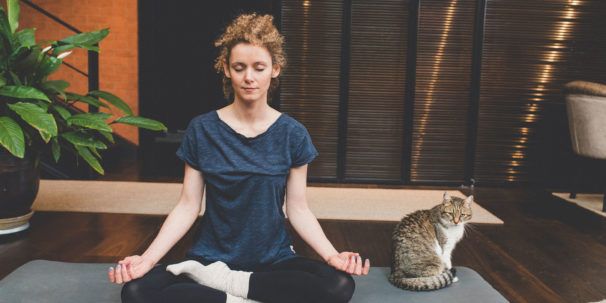How to practise mindfulness
In times of stress and uncertainty, it’s vital that we take care of our mental health. Learning how to practise mindfulness is a great place to start, and we explore the full details of how to do so.

Even at the best of times, it’s sometimes difficult to find balance in our lives. We’re often constantly bombarded by the endless flow of social media and the 24-hour news cycle. Finding inner peace in such conditions can be tricky, but not impossible. Learning how to practise mindfulness can be beneficial, so we’ve decided to outline how you can get started.
As well as examining what mindfulness is, why it’s useful, and how you can be more mindful, we also look at some exercises you can try. With a little know-how and planning, you can soon start reaping the benefits of this fascinating practice.
What is mindfulness?
Let’s start by exploring what we mean when we use the term mindfulness. Essentially, it’s the state of being fully aware of yourself and your surroundings, without judgement. This might seem like quite an intangible concept. After all, aren’t we all aware of who we are and where we are? However, in reality, it’s so easy to get distracted by our thoughts and ignore our surroundings, meaning we lose touch with ourselves and how we truly feel.
When we practise mindfulness, we spend time focusing on the present moment. It’s the process of drawing our attention directly inwards to ourselves as well as outward to what we’re doing. Again, these are concepts that are hard to capture in words, which is why it’s essential to experience them for yourself.
We’ll get to some techniques on how to be mindful and some exercises to help you focus your attention further on in this article. For now, it’s worth knowing that mindfulness is the ability to be fully present, without being overwhelmed by our situation. It can help us in our everyday lives, whether at home or at work, and it applies to topics as wide as the digital world and our nutrition.
A brief history of mindfulness and wellbeing
Mindfulness and wellbeing are subjects that have become popular areas of study in psychology over the last decade or so. Many recent studies have shown the potential for the practice of mindfulness to benefit a person’s overall wellbeing. When it comes to positive psychology, there is evidence to suggest that it can be used to help with things like stress, anxiety, depression, and even chronic pain.
This rather clinical view of mindfulness might make you think that it’s a relatively new practice. However, it’s actually a concept that dates back thousands of years and has its roots in Eastern religions such as Buddhism and Hinduism, as well as in Judaism, Christianity, and Islam. In the West, it has a more secular history, and people all around the world practise it both as part of their religion and in a non-religious way.
Nowadays, people use all kinds of mindfulness techniques to help them relax, improve their memory, and feel more connected with the world around them. What’s more, there are several benefits experienced by those who practise mindfulness.
What are the benefits of mindfulness?
With all of the many studies that have been conducted on mindfulness, there is a substantial body of evidence showing its benefits. Here are just some of the ways that being mindful can benefit you:
- Decreased stress. Mindfulness-based stress reduction (MBSR) is a clinical program that helps people deal with stress. A 2015 review showed that this technique can help people cope better with the stress of life and improve their health.
- Improved wellbeing. Being mindful can help you appreciate the important moments in life, allowing you to become fully aware and engaged in activities. Those who practise mindfulness often experience better regulation of their emotions and less reactivity to stressful situations.
- Reduced chronic pain. Although more large-scale studies are needed, there is evidence to suggest that regular practices such as mindfulness meditation can help people improve their chronic pain.
- Improved mental health. Mindfulness can help us identify unhelpful thoughts and feelings, allowing us to spot signs of stress and anxiety early. As such, the National Institute for Health and Care Excellence (NICE) recommends the practice as a way of managing depression.
- Improved creativity and memory. Several studies have found that certain forms of mindfulness can help boost creativity and working memory, making it a useful tool for creative problem-solving.
Perhaps most amazing is that some studies suggest that those who regularly practise mindfulness often experience positive changes in the structure of the brain. Clearly, learning how to practise mindfulness can bring some tangible benefits to many people.
-

 Leiden University Demystifying MindfulnessPsychology & Mental Health,Politics & Society
Leiden University Demystifying MindfulnessPsychology & Mental Health,Politics & Society
What are the three components of mindfulness?
Mindfulness is a broad term, and its practice is becoming increasingly popular around the world. To try and examine how different mindfulness practices impact us in different ways, the subject is usually separated out into three different components:
Present-moment attention
As you might expect, this component focuses on the here and now. It’s often the aspect that helps people feel happier overall, as it allows you to observe and appreciate thoughts, feelings and sensations as they arise. You’re not distracted by the past or worried about the future. Instead, you can understand yourself and your surroundings better.
Non-judgemental acceptance
We have a natural tendency of labelling our thoughts, emotions, and experiences as either good, bad or neutral. These judgements can be useful, as they can help us understand what does and doesn’t appeal to us. However, sometimes these judgements can go into overdrive, meaning we chase the good, avoid the bad, and ignore the neutral.
Non-judgemental acceptance helps you be more present and aware of all that you’re experiencing. It’s about changing your relationships with your judgements, acknowledging they’re temporary. Doing so can help you appreciate the many aspects of life, avoiding the dissatisfaction that often comes from only chasing the good.
Acting with intention
An essential part of mindfulness is the continued cultivation of awareness. What might start with five minutes of meditation can build to be a more persistent state. However, to get to such a level, you have to keep practicing and actively returning to mindfulness techniques.
What is mindfulness meditation?
There is a close link between mindfulness and meditation, but they are not quite the same thing. When we think of meditation, we imagine a temporary moment of calm and reflection amidst the chaos of our lives. Mindfulness, on the other hand, is a more persistent state, where you’re continually more aware of your thoughts and emotions, as well as how to handle them in the moment.
Meditation is a technique that’s frequently used when people practice mindfulness. It’s the ideal learning environment, as it helps us focus on the here and now for a specific amount of time. However, with regular practice, we continue to develop this awareness on a more permanent basis.
What other types of mindfulness are there?
Although mindfulness is a term that’s mostly used to describe the internal attention to our thoughts and feelings, there are other ways in which you can be mindful. Although many of the same principles apply, it’s still worth mentioning just how diverse the practice can be.
Digital mindfulness
All of us are surrounded by digital devices, and many of us spend a good portion of our day using the internet on our smartphones, tablets, and PCs. Yet our digital wellbeing isn’t something we often think about. Digital technology can impact our health and relationships and shape the society we live in.
Digital mindfulness is about taking charge of your wellbeing and balancing your use of the many devices in your life. Noticing and understanding how you spend your time online and the feelings this produces is an essential part of building a positive digital identity.
Mindful eating
Nutrition and wellbeing are two concepts that are closely linked. Healthy eating is hugely important for both our physical and mental health. Mindful eating is the process of applying a more conscious and healthy response to the way you eat, eating slowly and without distraction. By paying attention to your physical feelings before, during, and after you eat, you can notice things like your true hunger and how certain foods make you feel.
Relationship mindfulness
It’s not just your own happiness and wellbeing that can receive a boost from mindfulness. Your relationships, romantic or otherwise, can benefit from the self-awareness that comes with the practice. As you become more in tune with your own emotions, you’re able to express yourself more. You’re also able to deal with challenging emotions as they arise, either in yourself or in others.
Who can benefit from learning how to practise mindfulness?
Based on what we’ve outlined so far, you might assume that everyone can benefit from mindfulness. And, while it’s true that anyone can try it, it’s not always easy, and it might not be the right choice for everyone.
One of the most challenging parts of being mindful is that you have to pay attention to all of your thoughts. Naturally, this means that some of them are going to be more difficult than others, which can be distressing. If this is the case, you should seek advice from a trained professional.
As we’ll see, some of the most common mindfulness exercises require you to sit still for long periods and focus on your breathing. This might not be suitable for everyone, particularly if you struggle with mobility or breathing issues.
Although it can be a powerful tool, mindfulness isn’t for everyone. Taking care of your mental health is important, but it can be difficult. So, if you try mindfulness and find it doesn’t work for you, don’t be disheartened. There are plenty of other options available to you.
-

 National Yang Ming Chiao Tung University Using Creative Problem SolvingBusiness & Management
National Yang Ming Chiao Tung University Using Creative Problem SolvingBusiness & Management -

 University of York Digital WellbeingPsychology & Mental Health,Politics & Society
University of York Digital WellbeingPsychology & Mental Health,Politics & Society
How to be more mindful
It’s quite easy to go through much of your day on autopilot. Many of us find ourselves completing routine tasks like washing the dishes or sitting through meetings without having any memory of what we’ve done. This inattention can mean that we miss out on crucial information about ourselves, our life, and even our relationships and health.
Before we get into some exercises for how to practice mindfulness, let’s first look at some simple things you can do in your day-to-day to be more mindful. These basic activities can help bring your attention to your thoughts, feelings, and sensations, as well as the world around you:
Pick a time
If your routine is very samey, it can help to pick a specific time each day to be aware of yourself and that world around you. Whether it’s your daily exercise, your lunch break or your commute, spend some time taking in yourself and your surroundings.
Try new things
To notice the world in a new way, try mixing up your routine a little. It doesn’t have to be a huge step outside of your comfort zone – even something like trying a new place for lunch can give you a new perspective.
Pay attention to thoughts
For a lot of people, the downtime in between tasks can be filled with worries and racing thoughts. This over-busy state of mind can be exhausting. However, noticing these thoughts and feelings and addressing them can help you understand and process them.
Set reminders
Mindfulness is a continuous state, but it can take work to get there. Having reminders around your regular environment can help you to maintain this state of mind. Whether it’s notes around your desk, your favourite mug, or walking through a particular doorway, use these as triggers to remind yourself to be mindful.
Mindfulness exercises
Let’s turn our attention to some exercises that can help you practise mindfulness. Some of these take just a few moments to do, while others need a bit more time and space. However, each will give you the chance to get you thinking about your thoughts, feelings, and surroundings.
Mindful breathing and meditation
For some, the word meditation conjures up images of spiritual gurus sat cross-legged atop a mountain. In reality, just about anyone can practise meditation. Often, it’s a more in-depth and longer form of mindfulness. As such, it’s worth setting a time limit and timer for your meditation. Start with five minutes and work your way up. Here’s how to get started:
- Choose a comfortable and quiet spot where you won’t get interrupted and find somewhere relaxing and supportive to sit. Either cross your legs or sit upright in a chair.
- Close your eyes and take a few slow, deep breaths. Breathe in and out slowly, in through your nose and out through your mouth. Each cycle should take about six seconds. Allow your breath to flow all the way into your abdomen.
- As you breathe, focus your attention to the sound of your breath and the sensation of it flowing in and out of your lungs. Clear your mind of the thoughts that swirl around you, paying attention only to your breath.
- If you do notice other thoughts creeping in, acknowledge them and put them to one side, drawing your attention back to the centre. Your mind will wander, so focus on the sounds, smells, and feelings of your immediate environment.
That’s all there is to it, yet this simple technique can help calm your mind and refocus your attention. As you get used to the concept, you can extend the time you practise it for.
Mindful eating
If you have a busy schedule, it’s sometimes hard to appreciate the smaller things in life. This exercise focuses your attention on to a very specific task – eating.
Take a piece of fruit (or chocolate!) and mindfully eat it. Take some time to appreciate the taste, sensations, smells, and feelings that come with eating it. Slow the whole process down, savouring the flavour and texture of the food, allowing these sensations to linger in your mouth before taking another bite.
Mindful observation
At all times, we are surrounded by all kinds of natural wonders. However, we rarely pay attention to and appreciate them. This task helps you pay attention to some of the things you’d normally miss; helping you to feel more connected and grounded to the world around you.
- Choose a natural object from somewhere around you, such as a plant, insect or even the clouds in the sky. Watch it for a minute or two.
- Focus on what you’re looking at and relax as you notice various aspects of it. Try to approach the object as if you’re seeing it for the first time.
- Pay close attention to its structure, if and how it moves, its colours, and its presence in the space around you.
Again, it’s as simple as that, but you’ll find that you appreciate some of the natural wonder that the object and your surroundings have to offer.
Plants, in particular, can be beneficial for this exercise. As Dr Katie Cooper, founder of Bloombox Club highlights:
“As a psychologist and therapist, I witnessed the transformative power of plant care first-hand. In some cases, the act of nurturing plants was the only thing that allowed me to get through to my clients.”
There have even been studies that show a link between interactions with indoor plants and a reduction in psychological and physiological stress. Again, this is something that Dr Cooper mentions:
“Houseplants have been shown time and again, through scientific research, to reduce stress levels, increase productivity, and boost our wellbeing. The demands of our fast-moving lives mean less of us are taking the time to connect with nature, when it couldn’t be more important to do so.”
Final thoughts
Clearly, mindfulness can be a powerful tool that has all sorts of benefits. What’s more, it’s often easy and straightforward. Those who practise mindfulness are simply taking the time to be present and aware of their current self and situation.
That being said, it’s not for everyone. If it makes you feel frustrated or distressed, you may want to try other techniques to improve your mental wellbeing.
-

 University of Aberdeen Nutrition and WellbeingHealthcare & Medicine,Psychology & Mental Health
University of Aberdeen Nutrition and WellbeingHealthcare & Medicine,Psychology & Mental Health -

 The University of Glasgow Mindfulness: A Focus on AdolescentsPsychology & Mental Health,Teaching
The University of Glasgow Mindfulness: A Focus on AdolescentsPsychology & Mental Health,Teaching




